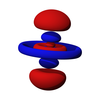|
Dsp2杂化
dsp2杂化(英語:dsp2 hybridization)是指一个原子内的一个n-1d轨道、一个ns轨道和两个np轨道发生杂化的过程。原子发生dsp2杂化后,上述n-1d轨道、ns轨道和np轨道便会转化成为四个等价的杂化轨道,称为“dsp2杂化轨道”。四个dsp2杂化轨道存在于同一平面上,且对称轴两两之间的夹角相同,皆为90°,故dsp2杂化也称为“平面正方形杂化”。[5]dsp2杂化一般发生在分子形成过程中。杂化过程中,能量相近的d轨道、s轨道和p轨道发生叠加,不同类型的原子轨道重新分配能量并调整方向。 一般只有过渡金属元素才能发生dsp2杂化。以[PtCl4]2-中的二价铂离子(Pt2+)为例:处于基态的Pt2+(电子排布式为:[Xe]4f145d8),它的一个空的5d轨道、一个空的6s轨道和两个空的6p轨道进行dsp2杂化,形成四个dsp2杂化轨道。[6]该过程中Pt2+的轨道排布变化情况如下图所示(图中灰色的配位电子对由4个氯离子提供): 
dsp2杂化
参考文献
|
||||||||||||||||||||||||||
![{\displaystyle Pt^{*}\,[Xe]5d^{8}{\frac {\color {White}/}{(dsp^{2})^{4}}}{\frac {\color {White}/}{6p}}}](https://wikimedia.org/api/rest_v1/media/math/render/svg/fd2bf79b02695c6de2ef262a4a30976eb3e0d287)
